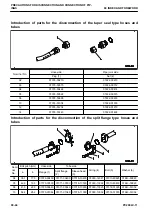
• Be sure to assemble all parts again in their original places. Replace any damaged parts and parts which
must not be reused with new parts. When installing hoses and wiring harnesses, be sure that they will not
be damaged by contact with other parts when the machine is operated.
• When installing high pressure hoses and tubes, make sure that they are not twisted. Damaged hoses and
tubes are dangerous, so be extremely careful when installing hoses and tubes for high pressure circuits. In
addition, check that high pressure hoses and tubes are correctly installed.
• When assembling or installing parts, always tighten them to the specified torques. When installing protec-
tive parts such as guards, or parts which vibrate violently or rotate at high speed, check again that they are
installed correctly.
• Never insert your fingers or hand when aligning 2 holes. Be careful not to get your fingers caught in a hole.
• Check that the measuring tools are correctly installed when measuring hydraulic pressure.
• Take care when removing or installing the tracks of track-type machines. Since the track shoe may sepa-
rate suddenly when you remove it, never let anyone stand at either end of the track shoe.
• If the engine is operated for a long time in a closed place
with poor ventilation, it may cause gas poisoning. Open
the windows and doors to ventilate the place well.
Precautions for slinging work and making signals
• Only one appointed worker must make signals and co-workers must communicate with each other fre-
quently. The appointed signaler must make specified signals clearly at a place where he is well seen from
the operator's seat and where he can see the working condition easily. The signaler must always stand in
front of the load and guide the operator safely.
k
Never stand under the load.
k
Do not move a load over a person.
k
Never step on the load.
k
Do not prevent the load from swinging or falling down by holding it simply with the hands.
k
The sling workers and assistant workers other than the guide must move to a place where they
are not caught between the load and materials or equipment on the ground or hit by the load
even if the crane starts abruptly.
• Check the slings before starting sling work.
• Keep putting on gloves during sling work. (Put on leather gloves, if available.)
• Measure the weight of the load by the eye and check its center of gravity.
• Use proper sling corresponding to the weight of the load and method of slinging. If too thick wire ropes are
used to sling a light load, the load may slip and fall.
• Do not sling a load with 1 wire rope alone. If it is slung so, it may rotate and may slip out of the rope. Install
2 or more wire ropes symmetrically.
k
Slinging with one rope may cause turning of the load during hoisting, untwisting of the rope, or
slipping of the rope from its original slinging position on the load, which can result in a danger-
ous accident.
• Hanging angle must be 60 ° or smaller as a rule.
• When slinging a heavy load (25 kg or heavier), the hanging angle of the rope must be narrower than that of
the hook.
,&
00 INDEX AND FOREWORD
SAFETY NOTICE FOR OPERATION
PC290LC-11
00-29



































